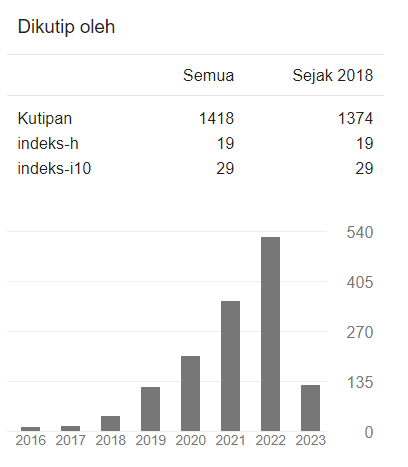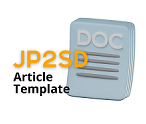Pengembangan Media Pembelajaran Berbasis Augmented Reality pada Materi Bangun Ruang di Kelas I SD
DOI:
https://doi.org/10.22219/jp2sd.v12i2.30333Keywords:
Bangun ruang, Pembelajaran Matematika, Augmented realityAbstract
Education in the era of the Industrial Revolution 4.0 is an education that highlights the use of digital technology in the learning process. Teachers or students are required to be able to improve their competence and skills. Digital technology in education is one reason teaching and learning activities should be supported to be more effective, efficient, and fun. This research aims to describe the development of augmented reality-based learning media on building materials in grade 1 elementary school, describe the design of augmented reality–based learning media as a solution to problems, describe the feasibility and testing requirements for the product that, and describe the final product of augmented reality – based learning media. The research used the Design-Based Research (DBR) research and development method using the Reeves model research stages, that is: 1) identification and analysis of problems; 2) develop solutions; 3) carry out an iterative process 4) reflection. The data collection technique is through data collection using preliminary studies and field studies. The instruments used in this research are interview instruments, expert judgment, questionnaires, and documentation. Based on the research results at SDN Sukarame, Tasikmalaya Regency, research data showed that the augmented reality–based learning media developed was suitable for use in learning. Feasibility is demonstrated from validation results by expert validators, and usability is demonstrated from the results of trials that have been carried out. So, based on the results of this research, the development of augmented reality–based learning media on spatial building materials can be used as an alternative media in learning in grade 1 elementary school.
Downloads
References
Al Arif Hidayatullah, P., Wayan Widana, I., & Ketut Suar Adnyana, I. (2022). Pengembangan Media JESSTAR Sebagai Media Pembelajaran Tematik Tema 9 Kelas VI SD. Jurnal Pemikiran Dan Pengembangan Sekolah Dasar (JP2SD), 10(1), 74–87. https://doi.org/10.22219/jp2sd.v10i1.20476
Akker, J. van den. (1999). Principles and Methods of Development Research. Kluwer Academic Publisher.
Akker, J. van den, Bannan, B., Kelly, A. E., Nienke Nieveen, & Plomp, T. (2013). Educational Design Research Part A: An Introduction (T. Plomp & N. Nieveen (eds.)). SLO, Enschede.
Apriansyah, A., Anugraha, D. M., Prakoso, G., Erdiham, K. N., & Priyana, R. (2017). Aplikasi Pengenalan Hewan dengan Teknologi Marker Less Augmented Reality Berbasis Android. DoubleClick: Journal of Computer and Information Technology, 1(1), 1. https://doi.org/10.25273/doubleclick.v1i1.1312
Aries, S. (2012). Solusi, Vol. 11 No. 24 Edisi September-Nopember 2012 MODEL PEMBELAJARAN INTERAKTIF BANGUN RUANG 3D BERBASIS AUGMENTED REALITY Oleh : Aries Suharso. Model Pembelajaran Interaktif Bangun Ruang 3D Berbasis Augmented Reality, 11(24), 1–11.
Armiyati, L., & Habib, F. M. (2022). Technological Pedagogical Content Knowledge (TPACK) Mahasiswa Calon Guru di Tasikmalaya. JIPSINDO (Jurnal Pendidikan Ilmu Pengetahuan Sosial Indonesia), 09(02), 164–176.
Astutik, K. P., Deviana, T., & Arifin, B. (2021). Pengembangan Media Interaktif Chesee (Cheerful House of Children) untuk Pembelajaran Tematik Sekolah Dasar. … Pemikiran Dan Pengembangan …, 9(1), 94–102. https://ejournal.umm.ac.id/index.php/jp2sd/article/view/18503
Beer, P., & Mulder, R. H. (2020). The effects of technological developments on work and their implications for continuous vocational education and training: A systematic review. Frontiers in Psychology, 11. https://doi.org/10.3389/fpsyg.2020.00918
Creswell, J. W. (2010). Reaserch Design: Pendekatan Kualitatif, Kuantitatif, dan Mixed. PT Pustaka Pelajar.
Dewanti, P., Supuwiningsih, N. N., & Saridewi, D. P. (2021). Utilizing Educational Technologies to Optimize Student and Teacher Learning at Dharma Laksana Mataram Orphanage. Journal of Innovation and Community Engagement, 2(1), 11–20. https://doi.org/10.28932/jice.v2i1.3601
Dwi Novia Rachmawati, Kurnia, I., & Laila, A. (2023). Multimedia Interaktif Berbasis Articulate Storyline 3 Sebagai Alternatif Media Pembelajaran Materi Karakteristik Geografis Indonesia di Sekolah Dasar. Jurnal Pemikiran Dan Pengembangan Sekolah Dasar (JP2SD), 11(1), 106–121. https://doi.org/10.22219/jp2sd.v11i1.22316
Ilmawan, M., & Kurniawan, N. (2022). Pengembangan Media Pembelajaran Movie Learning Berbasis Augmented Reality. Jambura Journal of Informatics, 4(2), 82–93. https://doi.org/10.37905/jji.v4i2.16448
Karunia, D. W. (2021). Pengembangan Media Pembelajaran Augmented Reality Pada Konsep Sistem Reproduksi Manusia. Skripsi, 1–52.
Koehler, M. J., Mishra, P., & Cain, W. (2013). What is Technological Pedagogical Content Knowledge (TPACK)? Journal of Education, 193(3), 13–19. https://doi.org/10.1177/002205741319300303
Kristina, Fatih, M., & Alfi, C. (2023). Pengembangan Media 3D Berbasis Augmented Reality Menggunakan PBL Materi Penggolongan Hewan untuk Meningkatkan Self Esteem Siswa Kelas V SD. Jurnal Pemikiran Dan Pengembangan Sekolah Dasar (JP2SD), 11(1), 59–72. https://doi.org/10.22219/jp2sd.v11i1.25677
Kustiawan, U., Yafie, E., & Surahman, E. (2021). Development Of A Video On Three-Dimensional Origami Creation Techniques To Improve The Handicraft. International Online Journal of Education and Teaching (IOJET), 8(1), 335–345.
Listyorini, Susanto, A., & Subagyo Tri, A. (2017). Pengenalan Rumus Bangun Ruang Matematika Berbasis Augmented Reality. Pros Iding SNATIF Ke -2 Tahun 2015, 29–32.
Mantasia, M., & Jaya, H. (2016). Pengembangan Teknologi Augmented Reality Sebagai Penguatan Dan Penunjang Metode Pembelajaran Di Smk Untuk Implementasi Kurikulum 2013. Jurnal Pendidikan Vokasi, 6(3), 281. https://doi.org/10.21831/jpv.v5i3.10522
Mursyidah, D., & Saputra, E. R. (2022). Aplikasi Berbasis Augmented Reality sebagai Upaya Pengenalan Bangun Ruang bagi Siswa Sekolah Dasar. Ejournal.Unisnu.Ac.Id, 4(1), 427–433. https://ejournal.unisnu.ac.id/jtn/article/view/2941
Negara, A. C., & Huda, N. 2020. Penerapan Augmented Reality pada Pengembangan Media Pembelajaran Pemodelan Bangun Ruang 3D untuk Siswa Sekolah Dasar Berbasis Android. In Bina Darma Conference on Computer Science (BDCCS). 2 (4): 145-152.
Pangestu, A., Susanti, E., & Setyaningrum, W. (2019). Pemanfaatan media pembelajaran berbasis augmented reality (AR) pada penalaran spasial siswa. Prosiding Seminar Pendidikan Matematika Dan Matematika, 1, 205–210. https://doi.org/10.21831/pspmm.v1i0.39
Plomp, T., & Nieveen, N. M. (2010). An introduction to educational design research.
Putraa, L., & Sentia, E. (2023). Pengembangan Modul Digital Berbasis Multimedia Untuk Siswa Kelas Iv Sekolah Dasar (Sd). JP2SD (Jurnal Pemikiran Dan Pengembangan Sekolah Dasar), 11(1), 1. https://doi.org/https://doi.org/10.22219/jp2sd.v11i2.23049
Rusnandi, E., Sujadi, H., Fibriyany, E., & Fauzyah, N. (2016). Implementasi Augmented Reality ( AR ) pada Pengembangan Media Pembelajaran Pemodelan Bangun Ruang 3D untuk Siswa Sekolah Dasar. Infotech Journal, 24–31.
Supandi, A., Sahrazad, S., Wibowo, A. N., & Widiyarto, S. (2020). Analisis Kompetensi Guru: Pembelajaran Revolusi Industri 4.0. Seminar Nasional Bahasa Dan Sastra Indonesia (Prosiding Samasta), 1–6.
Suroiya, M., & Prasetya, S. P. (2021). Pengembangan Media Pembelajaran Augmented Reality Pada Materi Peninggalan Kerajaan Hindu-Budha di Indonesia. SOSEARCH : Social Science Educational Research, 1(2), 93–104. https://doi.org/10.26740/sosearch.v1n2.p93-104
Utami, I. G. A. L. P. (2016). Teori Konstruktivisme dan Teori Sosiokultural: Aplikasi dalam Pengajaran Bahasa Inggris. Prasi, 11(01), 4–11. https://ejournal.undiksha.ac.id/index.php/PRASI/article/download/10964/7022
van den Akker, J. (1999). Principles and Methods of Development Research. Design Approaches and Tools in Education and Training, 1–14. https://doi.org/10.1007/978-94-011-4255-7_1
Wibowo, V. R., Eka Putri, K., & Amirul Mukmin, B. (2022). Pengembangan Media Pembelajaran Berbasis Augmented Reality pada Materi Penggolongan Hewan Kelas V Sekolah Dasar. PTK: Jurnal Tindakan Kelas, 3(1), 58–69. https://doi.org/10.53624/ptk.v3i1.119
Wijayanti, R., & Rachmawati. (2021). Pengaruh Acak Efektivitas Penggunaan Perangkat Matematika Augmented Reality Pada Materi Bangun Ruang. Prismatika: Jurnal Pendidikan Dan Riset Matematika, 3(2), 162–171.
Downloads
Published
Issue
Section
License
Copyright (c) 2024 Ana Mardiana

This work is licensed under a Creative Commons Attribution-ShareAlike 4.0 International License.
Authors who publish with Jurnal Pemikiran dan Pengembangan Sekolah Dasar (JP2SD) agree to the following terms:
- For all articles published in Jurnal Pemikiran dan Pengembangan Sekolah Dasar (JP2SD), copyright is retained by the authors. Authors give permission to the publisher to announce the work with conditions. When the manuscript is accepted for publication, the authors agree to automatic transfer of the publishing right to the publisher.
- Authors retain copyright and grant the journal right of first publication with the work simultaneously licensed under a Creative Commons Attribution-ShareAlike 4.0 International License that allows others to share the work with an acknowledgment of the work's authorship and initial publication in this journal.
- Authors are able to enter into separate, additional contractual arrangements for the non-exclusive distribution of the journal's published version of the work (e.g., post it to an institutional repository or publish it in a book), with an acknowledgment of its initial publication in this journal.
- Authors are permitted and encouraged to post their work online (e.g., in institutional repositories or on their website) prior to and during the submission process, as it can lead to productive exchanges, as well as earlier and greater citation of published work (See The Effect of Open Access).

This work is licensed under a Creative Commons Attribution-ShareAlike 4.0 International License.


















